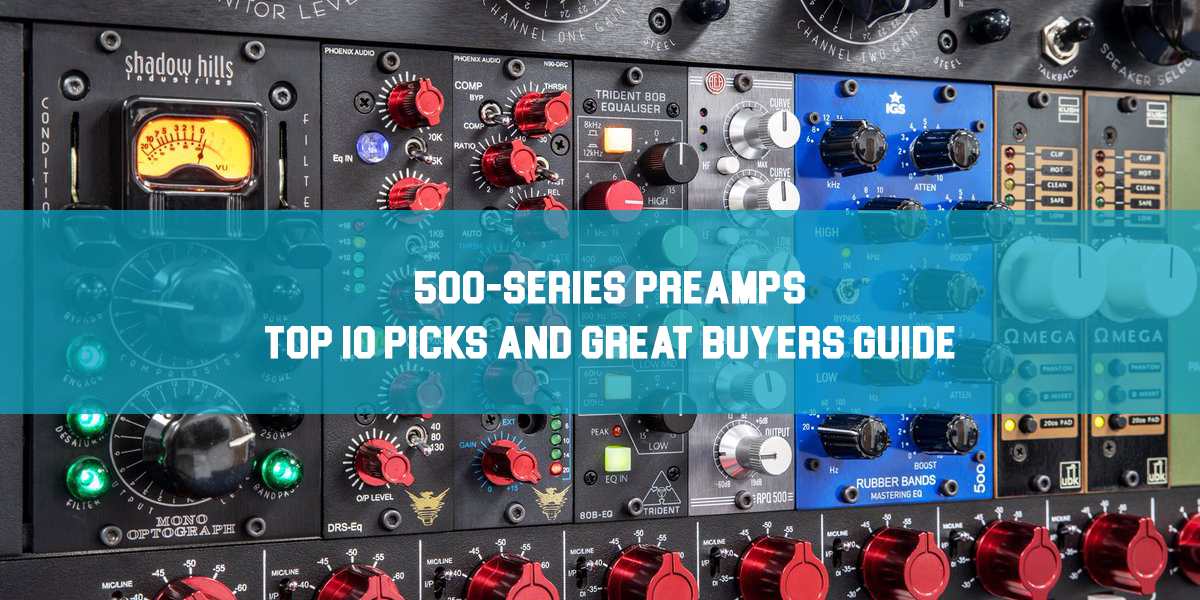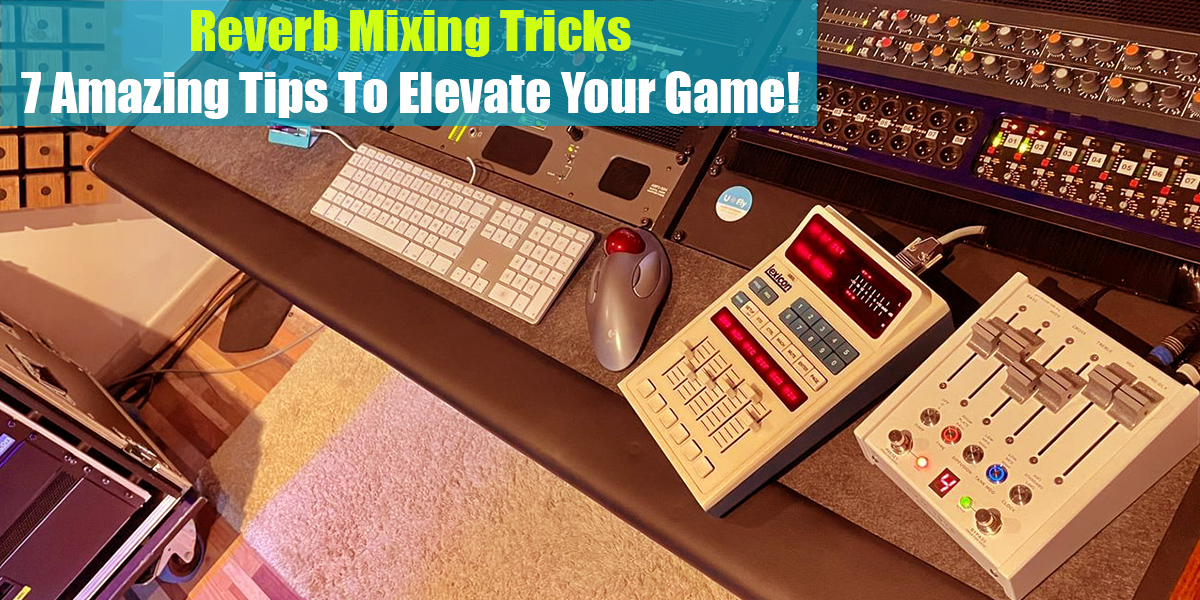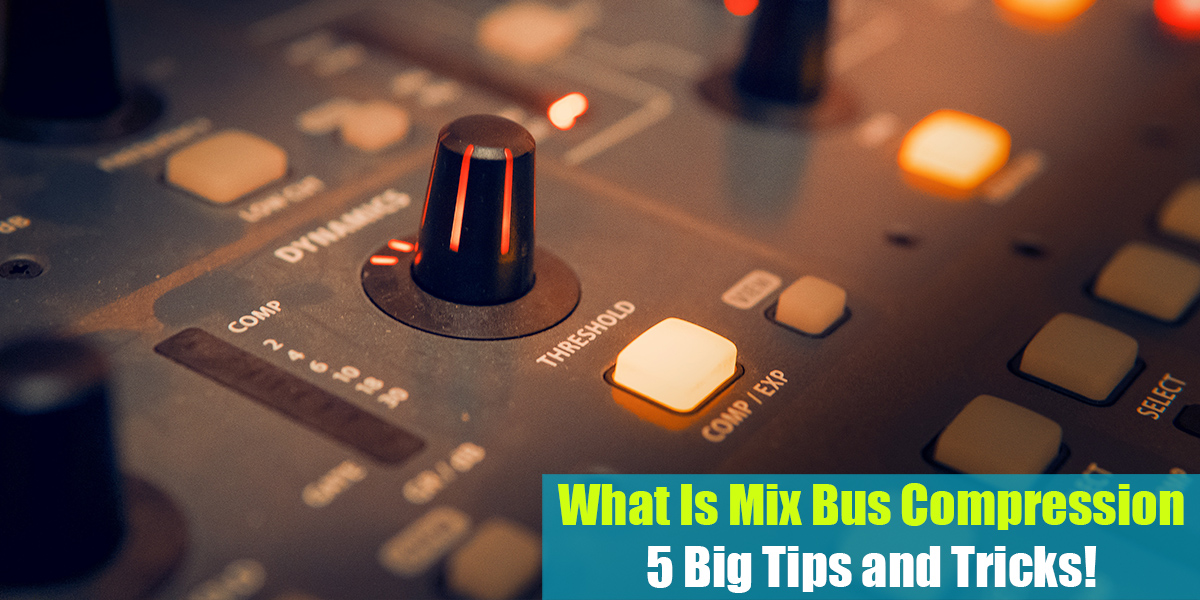Top 10 Best Parametric Equalizers!
Introduction
An equalizer, or EQ, is a type of filter that lets you adjust the volume level of a specific frequency or range of frequencies within an audio signal. In its simplest form, an EQ allows you to turn the treble and bass up or down, helping you shape the sound of, for example, your car stereo or your television.
In professional audio, equalization is a very refined skill used to sculpt the tone of instruments in a mix, fix issues caused by the acoustics of a room, or even just boost the bass.
No matter how it’s used, good equalization is essential for creating a great mix. When used correctly, an equalizer can make a sound feel closer or farther away, “fatten” or “thin out” a sound, and help blend or separate similar sounds in a mix so each can be heard clearly. It can also be used to adjust a sound system to account for the acoustics of a specific room or outdoor space.
This article will explain the features of parametric equalizers, provide a brief guide, and share our list of the best parametric equalizers available today.
Just so you know, we’ll list these parametric EQs in no particular order. The order is randomized—we don’t want to rank them from best to worst.
Listed below are our Top 10 Best Parametric Equalizers:
1. AMS Neve 8803 Stereoequalizer
The 8803 features a full 4-band EQ, along with high and low filters. The case is fairly shallow, and while the color scheme could be described as classic Neve, the build quality isn’t quite as reassuring as the chunky 1073s and 1081s.
The EQ is based on a “basic” Neve design—the 8108. These consoles date back to the late 1970s and were never as popular as the older Neve models. However, this was apparently due mainly to a poorly designed center section.
On the rear panel, you’ll find combo sockets for XLR or jack input, as well as separate XLR and jack output sockets. The power supply is an external lump-in-the-line, with a worryingly flimsy 8-pin DIN connection that’s oddly recessed and upside-down behind the rear panel—something that feels a bit like an afterthought.
Also on the rear—and this is interesting—there’s a B-type USB socket. This allows you to connect the unit to a Mac or PC for storing and recalling settings. The manual is only provided on CD-ROM (there’s no printed version), and wasn’t very helpful regarding this feature, simply suggesting you visit the Neve website’s downloads page to get the Recall Manual.
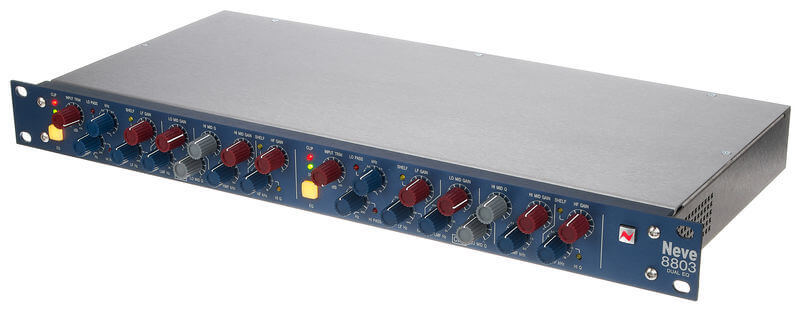
- EQ Mid High 0.8 kHz to 9 kHz
- Q range: 0.3 to 7 freely adjustable
- EQ Mid Low 120 Hz to 2 kHz
- Q range: 0.3 to 7 freely adjustable
- EQ Low 33 Hz to 440Hz
| PRICES | |||
|---|---|---|---|
AMS Neve 8803 Stereoequalizer |
|
2. Tegeler Audio Manufaktur EQP-1
The Tegeler Audio Classic Equalizer EQP-1 is inspired by vintage equalizers that use passive components—capacitors and inductors—in the EQ section, which gives it its unique character.
The EQP-1 features three main controls: Bass Boost and Cut, Treble Boost with adjustable bandwidth, and a High-Frequency Cut. Vocals remain transparent, instruments cut through the mix, and everything is easy to place in the stereo field without needing to turn up the volume.
Low-frequency instruments like bass and kick drum get the boost they need without becoming boomy. When you boost the treble, it doesn’t just sound like raised highs—everything simply feels fresher.
The EQP-1 includes a tube stage and high-quality input and output transformers.
Beyond its open and airy sound, the equalizer adds extra density and presence thanks to the tube and transformers. The low end becomes clearer and more defined, while the highs are smoother and more pleasant to the ear.
This effect happens as soon as the unit is in the signal path—even if you’re not engaging the EQ controls.
When used, the Classic EQP-1 can deliver deep, powerful lows without muddiness by boosting and cutting the bass frequencies simultaneously, while the top end stays natural, even with significant boosts.
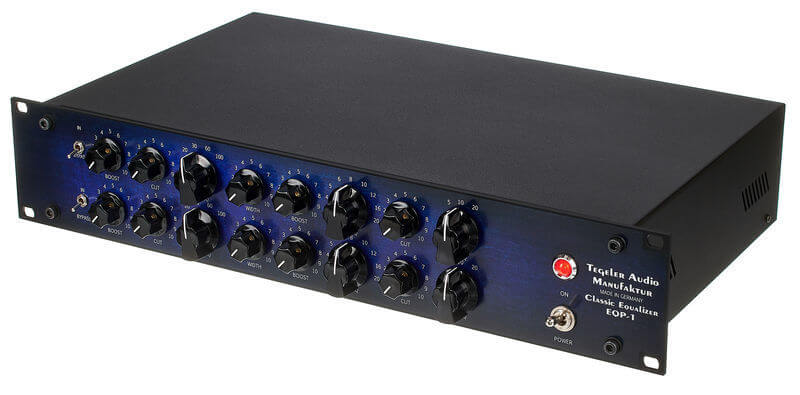
- High-quality input and output transformers
- Dimensions (H x W x D): 88.1 (2 HU) x 483 x 220 mm
- Internal power supply
- Bypass switch
| PRICES | |||
|---|---|---|---|
Tegeler Audio Manufaktur EQP-1 |
|
3. Tube-Tech HLT 2A
The Tube-Tech HLT 2A is a stereo high and low shelving EQ with a midrange T-filter control designed to tilt the entire frequency spectrum around a selected midrange point.
The Tube-Tech HLT 2A is a progressive, highly effective shaping EQ that remains simple to use. With the combination of two shelving bands and a midrange T control, it offers a powerful range of EQ shaping options that are extremely useful for tracking, mixing, and mastering engineers alike.
The shelving filters are built around a high-gain valve amplifier, while the T-filter uses a passive filter placed after the output amplifier. Each section features its own dedicated bypass switch, in addition to a total bypass switch.
The midrange T-filter “tilts” the entire spectrum around a selectable midrange frequency. Frequencies above that point increase (or decrease), while frequencies below that point decrease (or increase).
This unique design provides a powerful and remarkably efficient way to achieve beautiful-sounding overall equalization. As such, the Tube-Tech HLT 2A is destined to become a “go-to” equalizer in high-end mastering houses, smaller project studios, and everywhere in between.
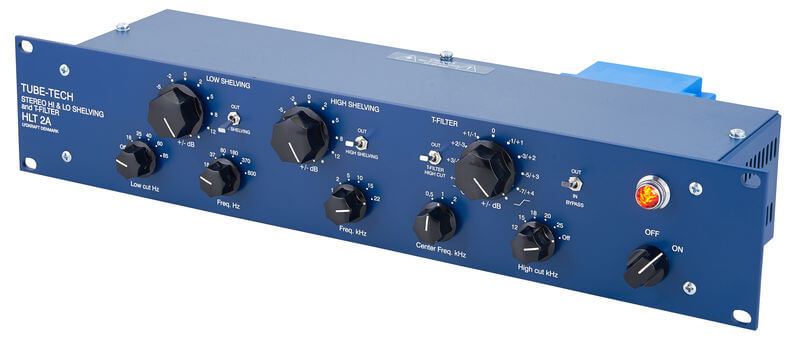
- Headroom (1% THD + n):> + 26 dBU
- Balanced XLR inputs and outputs
- Format: 19 “/ 2 U
- Depth: 165 mm
- Weight: 4.3 kg
| PRICES | |||
|---|---|---|---|
Tube-Tech HLT 2A |
|
4. Manley Massive Passive
The Manley Massive Passive Stereo Tube EQ is a two-channel, four-band equalizer with additional high-pass and low-pass filters. “Passive” means that the tone-shaping section of this innovative EQ uses no active circuitry at all.
Instead, only metallic film resistors, film capacitors, and hand-wound inductors shape your sound—think of it as a Pultec EQ on serious steroids. Massive, high-headroom, all-tube Manley make-up gain amplifiers carry your tracks to a whole new level. “Massive” truly fits this beast. You really need to hear it to believe it.
If you want a pure, natural, acoustic tone, you need an equalizer that treats your signal with equally pure methods. The Massive Passive uses simple passive components, taking advantage of their natural qualities rather than forcing a complicated circuit to chase some clinical or technical target.
Manley knows that artists use recording and mastering equalizers for creative reasons, so they designed this EQ with a little more art than science. The Massive Passive is made for everything—from bold EQ moves during tracking to the most subtle touches for vocals and mastering. It’s fundamentally different from other EQs, yet it draws on the best features of Pultecs, classic console EQs, parametrics, and graphics.
What sets the Massive Passive apart is that it allows twice as much EQ with half the coloration. You can push big high-frequency boosts without sibilance, and get incredible warmth without muddiness. That’s truly unique. Its distinctive design also brings a few quirks, ready to spark your creativity and sense of sonic adventure.
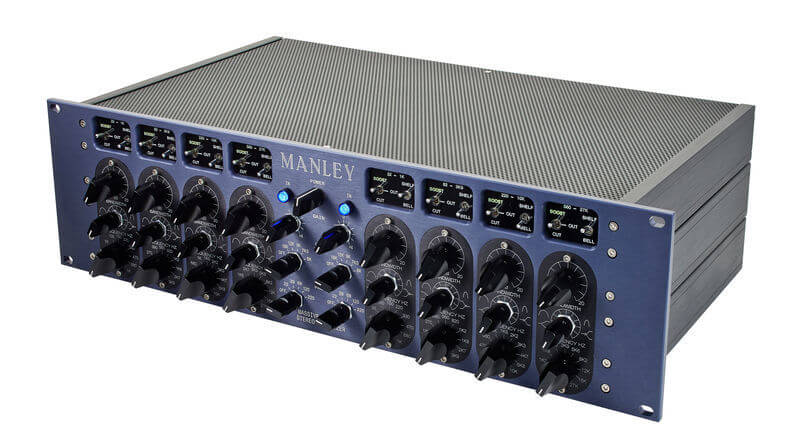
- 4 tapes per channel
- Circuit fully passive
- Overlapping frequency ranges
- Each band offers the possibility of Shelf or Bell
- Pro Band: Cut, Boost, and Off
| PRICES | PRICES | |||
|---|---|---|---|---|
Manley Massive Passive |
5. Heritage Audio Symph EQ
Heritage Audio offers a high-end take on the classic Baxandall curve with their SYMPH EQ, a stereo equalizer designed for skilled engineers. The Baxandall curve, known for its smooth, extended low and high-end response, delivers an easy, hi-fi approach for adding high-end polish, low-end fullness, and overall mix control.
This EQ gives you not only the classic Baxandall sound but even more. The SYMPH EQ includes features that make it an excellent choice for the stereo buss, such as stepped controls for precise recall, M/S functionality, and a tone inspired by classic British consoles—thanks to its carefully selected components and amplifiers.
If you want to add overall polish to your stereo buss during mixing or when self-mastering, this is an exciting option to consider.
The unit features the same unique Carnhill input transformers, made in Oxford, that are found in many other Heritage Audio products. The outputs are driven by 73-style Class-A output amplifiers, built with the same Carnhill output transformers as the rest of the Heritage line. Most importantly, the SYMPH EQ offers built-in Mid/Side capabilities.
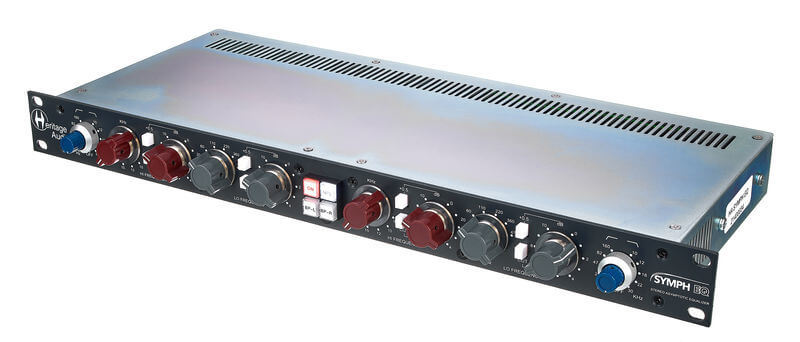
- 73 style class A output stages
- Asymptotic Equalizer Section
- Bypass Switch
- M/S Switch
- Housing: 19″ 1U
| PRICES | |||
|---|---|---|---|
Heritage Audio Symph EQ |
6. Drawmer 1974
As its name suggests, the 1974 is a vintage-style, 4-band parametric EQ inspired by classic gear from the 1970s. Dual-channel potentiometers give you control over the Low, Low-Mid, High-Mid, and High EQ bands. The Low-Mid and High-Mid bands allow you to adjust frequency, bandwidth, and boost/cut, while the Low and High bands let you adjust frequency, boost/cut, and slope. All bands offer a boost and cut range of ±12 dB.
The filter slopes in the 1974’s Low and High bands were chosen for their musicality, allowing you to shape the audio at the frequency extremes without introducing the harshness of brick-wall filters.
The Low band slope can be set to 6, 9, or 12 dB per octave, while the High band offers a choice of 6 or 12 dB per octave. A unique Peak setting for the Low band adds a narrow bell shape to the 12 dB per octave low-cut filter right at the knee frequency before it rolls off, giving you extra low-end weight without sacrificing clarity in the lowest frequencies.
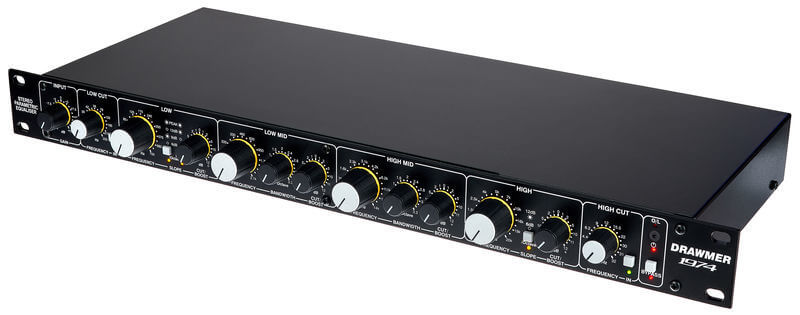
- Output impedance: <100 Ohm
- Output level max.: +26 dBu (10k Ohm load impedance)
- Frequency response: 20 to 20000 Hz +/-0.2 dB
- Distortion (THD+N) @ 1 kHz/ 0 dB: 0,007%
| PRICES | |||
|---|---|---|---|
Drawmer 1974 |
|
7. Dangerous Music BAX EQ
The BAX EQ marks Dangerous Music’s first step into the world of precise audio “processing.” This company is well-known for pioneering analog summing with its Dangerous 2-Bus, as well as bringing high-end monitoring and mastering consoles to the independent studio market. For this debut processor, Dangerous Music decided to introduce an old-school hi-fi concept to professional studios.
The Dangerous BAX EQ is a solidly built, 1U rackmount unit. It features a thicker, arguably more attractive faceplate than previous Dangerous models, complete with a bevel, and uses the same slick knobs found on the company’s top-tier mastering products. The back panel is straightforward: two XLR inputs, two XLR outputs, and an IEC power receptacle for built-in power.
On the front panel, from left to right, you’ll find the signature Dangerous Music orange logo, a highpass filter frequency selection switch (one switch controls both channels for the BAX filters), a low-end frequency selection switch, separate left and right gain switches for the low end, separate left and right gain switches for the high end, a high-end frequency selection switch, a lowpass filter frequency selection switch, and a backlit in/out switch that is dim when bypassed and glows brightly when engaged.
That’s pretty much it. We really appreciate that everything is switch-based, so there’s no risk of mistakes when writing down settings for recalls. Even the newest interns can reliably recall BAX settings without trouble.
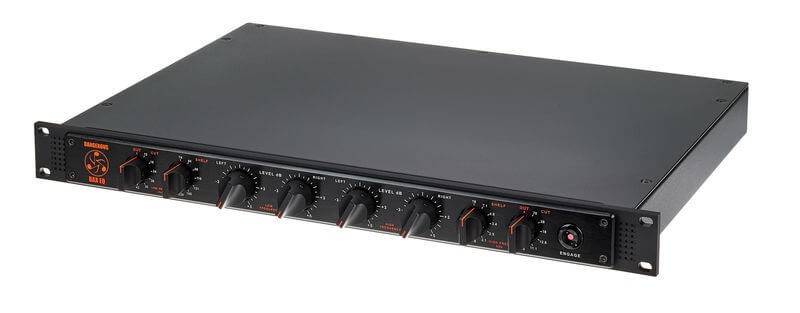
- 7 Positions High Pass and Low Pass Filter on Relays for Phase Equality
- 8 Position high and low frequency selection
- 5 dB Cut and Boost Controls in 1 / 2dB for accurate settings
| PRICES | PRICES | |||
|---|---|---|---|---|
Dangerous Music BAX EQ |
|
8. Elysia xfilter Mastering Edition
Elysia is a German developer known for its high-end analog audio equipment and software, with a reputation for top-notch audio design. Their XFilter is a four-band “Class A stereo equalizer.” It features one set of controls for both left and right channels, which are stereo-ganged (linked) and detented, making accurate and recallable EQ settings simple.
While it isn’t a dual-mono equalizer, you can run a mono signal through one channel if you wish. However, the XFilter shines when used on stereo outputs from an audio interface, connected to the insert points of an analog mixing console, or as part of a mastering setup.
Elysia uses computer testing to measure the tolerances of the potentiometers, achieving a typical channel match within 0.1dB. This technical approach makes the stereo equalizer much more affordable compared to designs using switches with individually measured resistors. The XFilter includes balanced XLR inputs and outputs.
The EQ section features four bands: a low shelf (20Hz to 900Hz), a low mid band (45Hz to 2.2kHz) with switchable narrow or wide Q (1.0 and 0.5, respectively), a high mid band (300Hz to 16kHz) with switchable Q, and a high shelf (700Hz to 28kHz).
Additionally, the high and low shelves can be switched to act as high-cut and low-cut filters, adding extra versatility. Another unique feature is a single button that inserts a passive high-end boost, creating a gentle resonant peak at 12kHz and a high-frequency roll-off at 17kHz as part of the filter slope.
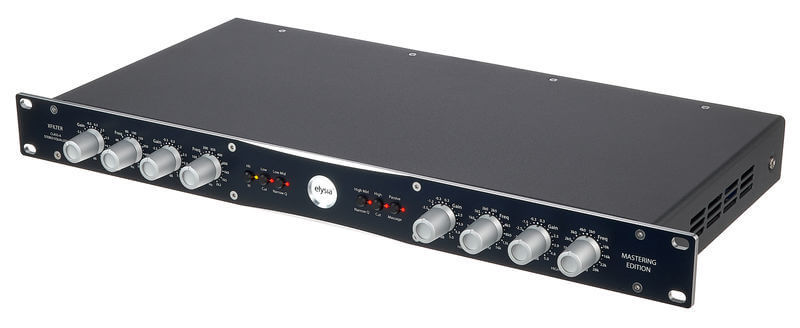
- 2 Line inputs: XLR and 6.3 mm jack
- 2 Line outputs: XLR and 6.3 mm jack
- 2 Additional line outputs: 6.3 mm jack
- Aluminium housing
- Format: 19″ / 1 U
| PRICES | |||
|---|---|---|---|
Elysia xfilter Mastering Edition |
|
9. Empirical Labs El-Q Lil FrEQ
Weighing in at 14 lbs, the Lil FrEQ is a fully parametric, four-band mono equalizer featuring high and low shelving bands, a high-pass filter, and a dynamic section that can function as both a de-esser or a high-frequency “knee” limiter.
Input and output are available via both XLR connectors and 1/4-inch jacks. A second male XLR connector provides a transformer output for that classic audio character. The front panel’s instrument input offers an unbalanced, high-impedance connection with 10 dB of initial gain, making it ideal for lower-level, high-impedance signals.
The four parametric bands are adjustable by +/-14 dB and operate with less than 0.0007 percent total harmonic distortion, making the Lil FrEQ arguably the lowest distortion analog parametric EQ ever built. Each section can be independently bypassed.
The low and high shelves have fixed corner frequencies at 120 Hz and 4 kHz, respectively, and are adjustable by +/-10 dB. The high-pass filter features an 18 dB per octave slope with eight selectable frequencies between 30 and 330 Hz. Sonically, it delivers rich coloration reminiscent of the low-frequency warmth found in vintage classic equalizers.
The dynamics section includes a de-esser and a high-frequency “knee” limiter, which can be placed either before or after the EQ, allowing users to decide if its performance is influenced by the equalization. Four LEDs display the amount of gain reduction: -1.5 dB, -8 dB, -14 dB, and -24 dB.
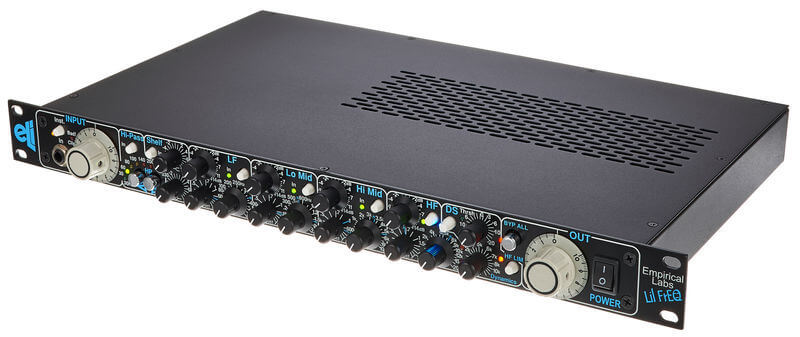
- Instrument input on the front
- Frequency range: 5 Hz – 140 kHz
- XLR and 1/4 “TRS inputs and outputs
- Format: 19 “/ 1U
| PRICES | |||
|---|---|---|---|
Empirical Labs El-Q Lil FrEQ |
|
10. Bettermaker Mastering Equalizer
The Bettermaker Mastering EQ is a powerful analog mastering equalizer that combines a stereo Pultec-style EQ with a three-band parametric EQ, high-pass filter, and advanced features such as USB connectivity, total recall, and a 5-inch multi-touch performance touchscreen.
Inspired by the innovative EQ232p, the Bettermaker Mastering EQ blends the classic Pultec sound with flexible parametric controls, adding an extra band and shelving options for the two outer bands. Each shelf offers up to 6dB of boost or cut, along with adjustable center frequency, bandwidth, and Q.
The three parametric bands are designed to cover a wide range of applications: EQ1 covers 23Hz to 520Hz, EQ2 spans 170Hz to 3.8kHz, and EQ3 reaches from 1kHz to 23kHz. A new solo mode lets you focus on mono or side signals in M/S mode, as well as left or right channels in stereo mode.
The 5-inch multi-touch backlit display brings the plugin to life, showing a live EQ curve, Peak/RMS levels, and an RTA analyzer. Four encoders with push-button action make it easy to access and adjust all parameters.
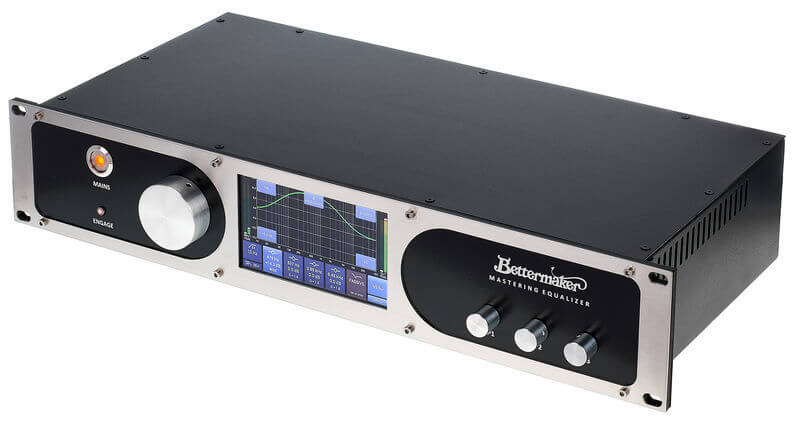
- 2 Balanced XLR inputs
- 2 Balanced XLR outputs
- Dimensions (H x W x D): 19 “x 2 U x 250 mm
- Weight: 5.5 kg
| PRICES | PRICES | |||
|---|---|---|---|---|
Bettermaker Mastering Equalizer |
What is a Parametric Equalizer?
Parametric EQ is the most configurable type of equalizer when compared to other varieties of EQ.
Parametric EQ offers continuous control (within defined ranges) over most, if not all, of the key parameters of equalization. Because of this, parametric EQs are often the top choice for tone-shaping and precise, surgical EQ tasks.
The number of adjustable parameters and how much each can be changed may vary from band to band, largely depending on the filter type used for each band. Of course, some parametric EQs offer more control than others.
Parametric EQ designs work especially well as audio plugins, where digital signal processing and computer programming can create extremely accurate and versatile EQs.
More advanced EQs, like linear phase EQ and dynamic EQ, also usually offer parametric control and are most often found in plugin form as well.
The available parameters depend on the filter type (which is often selectable, especially in EQ plugins). Most parametric EQs have between three and seven bands, though plugins can offer many more than this.
Parametric EQs can be designed to process mono, stereo, mid-side, and other multi-channel audio formats.
What Are the Advantages of Parametric EQ?
If you’re wondering why a parametric EQ is so important, here are a few of its key benefits:
- Feedback cancellation – If you’ve ever attended a live music event, you might have noticed those harsh, shrieking sounds in the background. This usually happens when microphones are too close to the speakers. Parametric equalizers help solve this problem by filtering out the troublesome frequencies that cause feedback.
- Studio monitor tuning – All speakers have certain peaks and dips at different frequencies. If you have a home studio, you want your speakers to have a flat response. This is where parametric equalizers come in—they help smooth out those peaks and dips for more accurate sound.
- Elimination of unwanted noise – Sound producers often use parametric equalizers to remove background noise. This could be anything from the sound of a piano pedal to the noise made by guitar strings when they’re being picked.
- Enhancement of studio performance, especially in recording, mixing, and production – Parametric EQs are valuable for making precise frequency adjustments. They offer deliberate and sophisticated control over your sound.
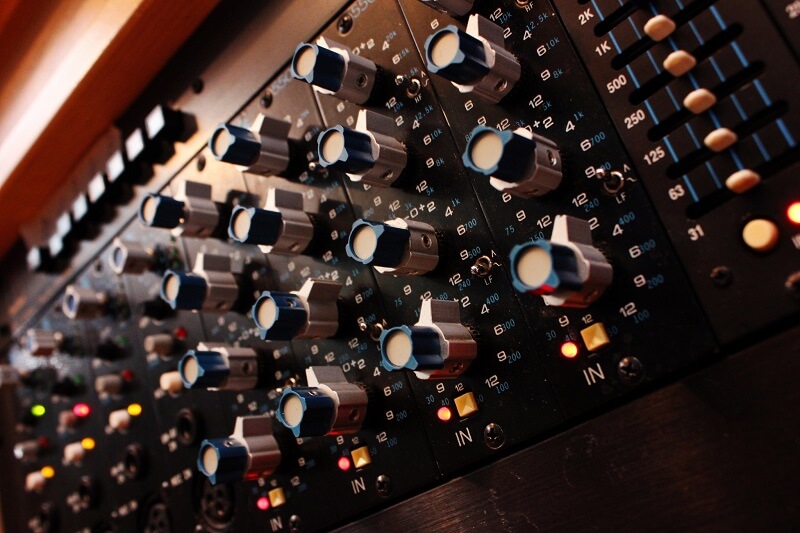
Parameters of Parametric EQ
Center Frequency
The center frequency parameter lets us control the specific frequency around which a bell/peak or notch filter will be centered.
Gain (Boost/Cut)
The gain control, measured in decibels (dB), sets the relative amplitude (boost or cut) applied to a band in a parametric EQ.
Quality Factor (Q)
The quality factor, or “Q,” is a dimensionless value that determines the ratio of the center or resonant frequency to the filter’s bandwidth.
Cutoff Frequency
Cutoff frequencies are defined as the points where filters cause half-power, or -3 dB, of attenuation.
The cutoff frequency parameters in parametric EQs allow us to set the cutoff points for high-pass, low-pass, and band-pass filters.
Slope
Some equalizer bands offer slope controls to adjust the roll-off rate of their filters. These controls change the order of the filter, affecting the slope (measured in dB per octave or dB per decade). Some EQs even provide a brick-wall setting.
Filter Selection
Some or all bands in a parametric EQ may let you choose the filter type.
Filter options in a parametric EQ may include:
- Low-pass filter
- Low shelf filter
- Bell curve filter
- Notch/band-stop filter
- High-pass filter
- High shelf filter
- Band-pass filter
Frequently Asked Questions
What is the primary function of an equalizer in audio processing?
An equalizer allows users to adjust the volume level of specific frequencies within an audio signal, enabling control over the tonal characteristics of the sound.
Why is good equalization crucial in audio mixing?
Effective equalization is essential for achieving a high-quality mix by providing the ability to manipulate proximity, tone thickness, and separation between sounds, ensuring each element is heard as intended and optimizing the acoustic response of the environment.
How is equalization perceived in professional audio environments?
In professional audio settings, equalization is considered a nuanced art form that can shape instrument tones, correct room anomalies, and enhance aspects like bass frequencies.
Conclusion
We believe that choosing any one of these 10 models would be a great decision. Each offers something unique that you won’t find in any other parametric equalizer.
If you think we missed an analog EQ model, let us know in the comments and we’ll do our best to cover it!


